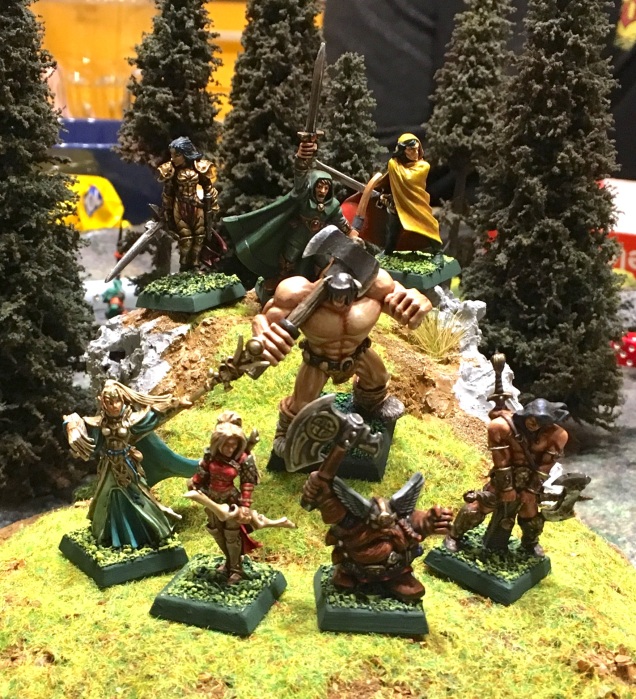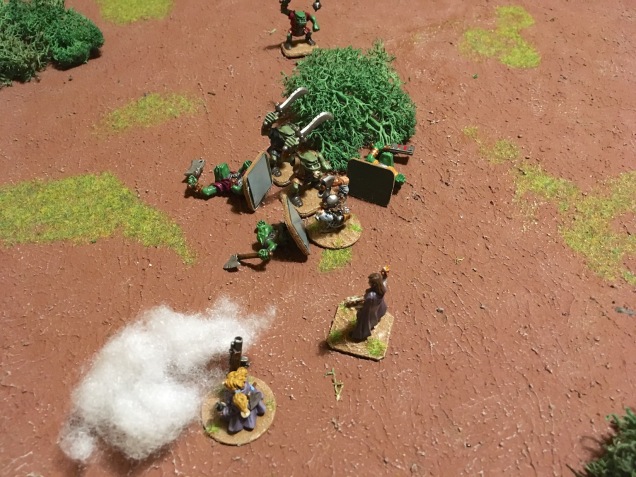I finally had the chance to play two games of Andrea Sfiligoi’s new cooperative fantasy game Sellswords & Spellslingers. For the first game, Sigur, Daniel, Virago and me met at Virago’s place to try out the second scenario (I chose the second one for the game as it features an attack on an Orc camp, and Virago has lots of Orcs, Goblins and even Orc huts). Each of us got two characters, which I had prepared in advance. Our party attacked quite aggressively and, despite some early setbacks (our thief William the Wrongfully Accused wanted to ambush the Orcs and was himself ambushed) we managed to take out all the bad guys. The dwarven berserker Doomli the Depressed was especially efficient, while Hyacinthe the Helpful proved to be a completely useless wizard.
The game was fun, but it also felt a bit easy. However, we fought pretty recklessly, something we would probably not do in a real campaign setting. Also, I made some minor mistakes with the rules and forgot some things which, had I thought of them, might have made the scenario a bit more difficult for us.

Two days later, K. and I decided to give it the rules a try at home. We both created two characters and played the first scenario from the book, where we had to cross the table to escape from Orcs. This game felt more tense than the first: We proceeded more cautiously and, although all of us managed to escape, three out of four were down to 1 HP. And I think we would have had more trouble had we stopped to loot, which we didn’t, meaning our characters are still pretty poor. We both liked the game very much and want to start a campaign with our characters.

I’ve been waiting for quite a while for a cooperative miniatures wargame and had very high expectations for Sellswords & Spellslingers. After having played two games, I have to say that those expectations were not disappointed: Andrea Sfiligoi did a great job!

Sellswords uses Andrea’s trademark activation mechanics, albeit this time with D20: To get an activation, you have to roll an 8+. You may roll up to three dice, therefore possibly getting three activations. However, if you fail a roll, you draw a card from the Events deck, which usually activates the monsters – before you may take any actions.
The fact that the actions of the foes are triggered by the players’ failed activation rolls has two interesting consequences: First, it means that there is no separate phase for the monsters’ movement, like e.g. in Zombicide. Gameplay therefore is much more fluid – there is no planning phase followed by collectively being clobbered by the bad guys, but a constant flow of action. Second, it means that the monsters’ behaviour is tied into the risk-reward-mechanics of player activations: If you want lots of activations, you have a high chance of also getting lots of monster activities, but if you play it safe, you might get no activation… And as monster activations may harm your friends, it is important to keep the situation of the whole party in view.
This is a very clever way of designing a cooperative game, which elegantly avoids some of the pitfalls of such games (e.g. by eliminating a ‘planning phase’ it’s harder for an ‘alpha player’ to determine what others should do).

The game does not feel as nerve-wrecking and dangerous as Zombicide, but then the two games offer different experiences: In Zombicide, you’re a bunch of regular guys trying to survive an onslaught of Zombies, while in Sellswords, you are adventurers out on a, well, adventure. It´s more a RPG light than a survival game.
This is confirmed by the rules, which offer not only rules for some role-playing, but also scenarios with narrative twists. Some of the scenarios have NPCs you can interact with and it will be easy to add more narrative or NPCs . Furthermore, Andrea has already published a mini-supplement for the game, which seems to have a real storyline where the players have to investigate the strange doings of an evil Count.
I have to admit that this is something I have been looking for at the moment. Being a bit tired of dungeonmastering, especially of the huge amount of preparation involved, but still wanting to play something that feels like a RPG, Sellswords hits just the right spot. Without investing a lot of time and effort, I can devise a scenario with a little story and then I myself can actually play it together with my friends, instead of being the guy who is responsible for the others to have fun.

The only drawback is that you need quite a lot of figures. Of course, you can also use counters, but the game seems to be aimed at people who already have a collection of fantasy figures. Now I’m not one of them and it may be a bit crazy to start such a game from scratch, but it really caught my imagination and offered me the excuse to dive headlong into 28mm fantasy. I’ve painted up the stuff I had lying around (mainly old HeroQuest figures and a couple of figures I got from Bad Squiddo Games some time ago) and already ordered more stuff.
If you like skirmish games and cooperative games with a bit of role-playing, Sellswords & Spellslingers is highly recommended! I’ll keep you posted on how our campaign is going.



Looking forward to getting this! Our regular D&D is on hiatus for now, and people are itching to roll some dice. This might be just the thing.
Great to hear! Thanks for posting your thoughts. I have purchased and printed the rules and cards and I’m looking forward to playing this with my wife and daughter. I was really attracted by the cooperative aspect as well and tying the risk-reward activation roll into monster activation is genius. Hoping to try this out this weekend with my wife. And we have plenty of miniatures lol – too many – so this might get us to paint some more.
First game next Saturday — maybe a test game for just myself in between. I found it odd that there aren’t that many “Monster activates” cards in the deck — I’m thinking of adding another 4 or 5 of those. It seems like the default action should be that a monster activates instead of some of the more esoteric items like traps, ambush, etc. But I’ll see how it goes before I change anything.
On Facebook, Andrea said that the low number of cards is deliberate: it is assumed that you cycle several times through the deck and as you remove some of the more esoteric event cards, the monster increasingly get more actions. Quite a clever mechanics to model an escalation of events!
Ah, that makes sense! This is why I try to always play a few games as the rules are written before making any changes. That IS a cool way to escalate the tension! (And you’re right, I hadn’t thought about Ambush being an activation as well). Thanks for your insights!
And don’t forget that ambush is actually a monster activation – a dangerous one too, as it adds a new monster and gives the monster a bonus in close combat!
Lovely miniatures and a great read. Thanks for sharing!
nice write-up and a shout to Thrud! Lovely to see some old school citadel on the table
Thanks Dave!